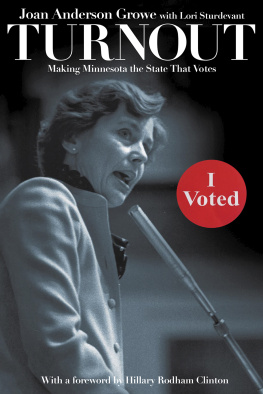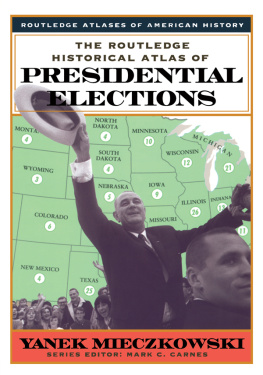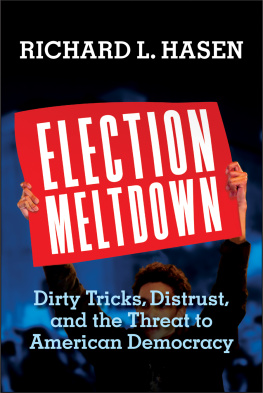John Agnew is professor of geography at the University of CaliforniaLos Angeles.
J. Clark Archer is professor of geography at the University of NebraskaLincoln.
Jill A. Archer is a retired media specialist, Lincoln Public Schools, Lincoln, Nebraska.
Matthew Balentine is assistant professor of geography at the University of North Alabama.
William Berentsen is professor emeritus of geography at the University of ConnecticutStorrs.
Jordan Brasher is assistant professor of geography at Columbus State University.
Stanley D. Brunn is emeritus professor at the University of Kentucky.
J. Miles Coleman is associate editor of Sabatos Crystal Ball at the University of Virginia Center for Politics.
Jason Combs is professor of geography at the University of Nebraska at Kearney.
Thomas Craig is assistant professor of geography at Mayville State University.
Carl T. Dahlman is professor of geography at Miami UniversityOxford.
Fiona M. Davidson is associate professor of geography at the University of Arkansas.
Richard L. Engstrom is professor emeritus of political science at the University of New Orleans and a visiting research professor at the University of Houston.
Benjamin Forest is associate professor of geography and a member of the Centre for the Study of Democratic Citizenship at McGill University.
Erin H. Fouberg is associate vice president for academic affairs and professor of geography at Northern State University.
Kenneth French is associate professor of geography at the University of WisconsinParkside.
John Heppen is professor in geography at the University of WisconsinRiver Falls.
Juan Herrera is assistant professor of geography at the University of CaliforniaLos Angeles.
Heather Hollen is a science writer and editor at the University of Oklahoma Hudson College of Public Health.
Kimberly Johnson Maier is instructor of geography at South Dakota State University.
Larry Knopp is emeritus professor of geography at the University of WashingtonTacoma.
Christopher R. Laingen is professor of geography at Eastern Illinois University.
Jonathan Leib is professor of geography at Old Dominion University.
Dwayne Liller completed his masters degree in geography at the University of ColoradoColorado Springs.
Christopher Maier is an independent scholar and educator.
Kenneth C. Martis is emeritus professor of geography at West Virginia University.
Daniel A. McGowin is assistant professor of geography at Jacksonville State University.
Rashauna Mickens Hintz is instructor of human geography at the University of Arkansas.
Matthew Millett is an instructor in the Department of Politics, Geography, and International Studies at University of WisconsinRiver Falls.
Richard L. Morrill is emeritus professor of geography at the University of Washington.
Wyatt Pajtash is a GIS coordinator for the Ho-Chunk Nation in Black River Falls, Wisconsin.
Tony Robinson is associate professor of political science at the University of Colorado at Denver.
Fred M. Shelley is emeritus professor of geography at the University of Oklahoma.
Rebecca Theobald is assistant research professor of geography and environmental studies at the University of ColoradoColorado Springs.
Robert H. Watrel is associate professor of geography at South Dakota State University.
Gerald R. Webster is emeritus professor of geography at the University of Wyoming.
Katie Weichelt is an independent scholar and educator.
Ryan Weichelt is professor of geography at the University of WisconsinEau Claire.
Cameron Wingren is a graduate student in forestry and aviation at Purdue University.
D emocratic nominee Joseph R. Biden won the 2020 presidential election by carrying twenty-seven states and the Second Congressional District of Nebraska (which allocates its electoral votes by congressional district), giving him 306 of the 538 votes in the Electoral College. Biden won approximately seven million more popular votes than Donald J. Trump, breaking Barack H. Obamas previous record by winning 81.2 million votes, the most votes ever cast for a candidate in US history. Turnout was so high in the 2020 election that Trump also broke Obamas record, winning 74.2 million votesalmost five million more than Obamas record 69.5 million votes. The 2020 election came down to a few key swing and tipping-point states including Arizona (Biden won by 10,457 votes: 49.36 percent to Trumps 49.06 percent), Georgia (Biden won by 11,779 votes: 49.47 percent to Trumps 49.24 percent), Wisconsin (Biden won by 20,682 votes: 49.45 percent to Trumps 48.82 percent), and Pennsylvania (Biden won by 80,555 votes: 50.01 percent compared to Trumps 48.84 percent). Surprisingly, Georgia cast their electoral votes for a Democratic candidate for the first time since 1980. Arizona also cast their electoral votes for a Democratic candidate for the first time since 1996.
It is important to look at elections through the geographic lens as it showcases spatial and temporal changes of territorial constituencies, providing insights into the dynamics of American political processes and outcomes at different scales. Geographically, the pattern of support for Biden and Trump is like patterns that have been around since the early 1990s. However, with Georgia, Biden was the first Democrat to carry a southeastern state other than Florida for the first time since 2008. Like the 2016 election, Biden won the Northeast and Pacific Coast, while Trump won the Southeast, the Great Plains, and the Mountain West regions. However, unlike the 2016 election, the Democratic blue wall states of Pennsylvania, Michigan, and Wisconsin held for Biden. He also made inroads in the Mountain West by winning Arizona. Ultimately, Biden flipped five states and one congressional district from Republican in 2016 to Democratic in 2020.
An analysis of the county-level map confirms the continued sharp divide between rural and urban. The 2020 county scale map looks quite similar to the last several elections, with rural Republican areas mapped in red and urban Democratic areas mapped in blue. With more rural than urban counties in the United States, Trump won 2,560 counties while Biden won only 471 counties. While the county scale map looks like a Trump victory, counties do not votepeople do. A large portion of the counties that Biden won were urban areas with millions of more voters.
THE 2020 ELECTION
At the time of the November 2020 election, President Trump had been impeached, COVID-19 cases were climbing, more than 237,000 Americans had died of COVID, and the vaccine was still weeks away. After the election, the sitting US president refused to accept the election results and vigorously touted voter fraud accusations, which resulted in numerous recounts and failed court cases. Trump finally conceded the election on January 7, 2021, the day after the January 6 insurrection of the Capitol.
The contributors to this atlas analyze the primaries leading up to the 2020 US presidential election, the campaigns, and the US presidential election from a political geography standpoint. Since Trump ran virtually unopposed, analysis of the primaries focuses on the Democratic primary. The Democratic primary was a diverse pool of candidates, including six women and the first openly gay candidate for president. On the hundredth anniversary of womens suffrage, the United States saw the election of the first female vice president, Kamala Harris.




![T. H. Logwood - Voter Fraud and the 2020 Presidential Election; “Joe Biden wins by a Miraculous Landslide” [with appendices]](/uploads/posts/book/259666/thumbs/t-h-logwood-voter-fraud-and-the-2020.jpg)

